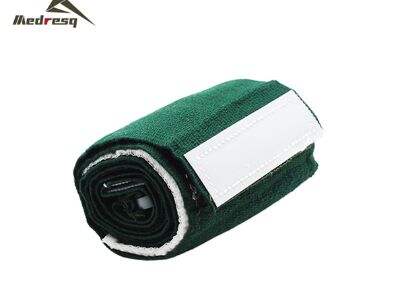When you get a cut or scrape, your body starts bleeding. At first, the bleeding can be a little frightening, especially if you notice a ton of red. Nonetheless, understand that bleeding is a cleansing process that assist you body. When you bleed, it helps wash out germs and dirt from the wound, which is extremely crucial for recovery. Health is good but the bleeding lasts too long and it is also needed to stop the blood for the body as soon as possible to start the healing process. This is where compression bandages come into play.
How Compression Bandages Stop Bleeding
Compression bandages work like superhero bandages; they can slow down bleeding much faster than if you do nothing. They function by applying light pressure to the wound. This pressure causes the blood vessels, the tiny tubes in your body that transport blood, to constrict. They squeeze the blood vessels so that they can not bleed as much and this gets the bleeding to stop quicker. It’s sort of like giving your wound a little hug to help it heal.
How to Properly Use Compression Bandages
It is extremely important that you apply compression bandages correctly in order to ensure that they effectively work. You first need to gently wash and clean the wound with soap and water. It is a very important step in the process as cleaning the cut helps to eliminate any dirt or bacteria that may lead to an infection. Then you should gently dry the area around the wound with a fresh towel, before applying the bandage. When you go to put the israeli compression bandage on, have it tight, which means it is going to fit snug, but not too tight—you don’t want to stop blood flow altogether. Last, tape or clip the bandage down so that it stays put and does not fall off.
Different Compression Bandages & Their Purpose
Elastic bandages, self adherent bandages, etc. They are elastic, which means they can apply distributed pressure all around the wound, which is ideal. A self-adherent type of bandage sticks to itself — no extra tape required, so it's easy to use. Pressure Bandages and Other Bandages Pressure emergency compression bandage are similar to crèpe bandages (for sprains), except that they are designed to hold on to the application of pressure at the site of a wound. If you have a bigger cut on your arm, for instance, an elastic bandage may be more appropriate.
Compression Bandage:83232 Benefits of Compression Bandages in First Aid
Honey in favours in speeding up the healing of wounds. When you do that with compression bandage, all you have to do is control the bleeding, and the wounds will heal faster, and they are less likely to be infected with bacteria or become a scar. This is a wonderful thing, as it means you can return to playing and have fun again much faster.
However, compression bandages could be a simple yet effective way to stop bleeding and promote wound healing. This means knowing how compression works, using the right method and choosing the right bandage type so you’re ready to treat small injuries like a first aid expert. Now you know, with the help of Medresq compression bandages, you can save the day in first aid and fix boo-boos fast and easy.
 EN
EN
 FR
FR
 DE
DE
 IT
IT
 JA
JA
 KO
KO
 RU
RU
 ES
ES
 AR
AR
 BG
BG
 HR
HR
 DA
DA
 NL
NL
 FI
FI
 EL
EL
 NO
NO
 PL
PL
 PT
PT
 RO
RO
 SV
SV
 TL
TL
 ID
ID
 SR
SR
 UK
UK
 VI
VI
 SQ
SQ
 TH
TH
 TR
TR
 AF
AF
 MS
MS
 CY
CY
 IS
IS
 HY
HY
 AZ
AZ
 KA
KA
 MN
MN
 MY
MY
 KK
KK
 UZ
UZ
 CS
CS



